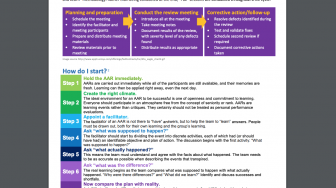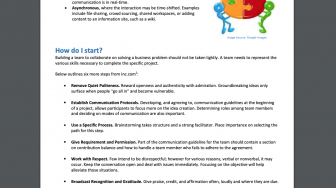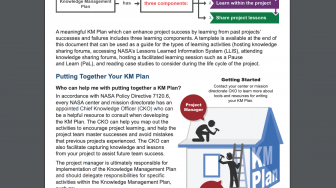results
-
 A Guide for Capturing Knowledge and Lessons Learned in Meetings
A Guide for Capturing Knowledge and Lessons Learned in MeetingsMeetings can be designed and executed as an effective knowledge capture and sharing tool.
-
 After Action Review (Pause and Learn)
After Action Review (Pause and Learn)“After Action Reviews (AAR) are an effective approach for capturing the knowledge gained from activities and projects. They’re great for ensuring that the lessons learned from one project or team are shared with the rest of the organization, with a view to improving overall performance.”
-
 APPEL KS Knowledge Capture and Transfer
APPEL KS Knowledge Capture and TransferThis page provides resources to help NASA leaders and teams take steps to build a culture that connects employees to knowledge when they join a team and that retains the critical knowledge held by experienced personnel in advance of retirement or other transitions.
-
 Collaboration
CollaborationCollaboration enables individuals to work together to achieve a defined and common business purpose. It exists in two forms : Synchronous, where everyone interacts in real time such as at in person or online meetings or asynchronous, where the interaction may be time-shifted such as in file sharing, crowd sourcing, or adding content to an […]
-
 Developing a Knowledge Management Plan
Developing a Knowledge Management PlanThis is a tool developed to help NASA Project managers to understand NASA NPD and NPR requirements for Knowledge Management (KM) Plans within a Project Plan, and the value of project learning.
-
 Diversity of Thought
Diversity of ThoughtDiversity of Thought (or Multiple Perspectives) is an effective approach used to obtain opinions, identify weaknesses in concepts, improve on ideas, and brainstorm new possibilities. There are many powerful techniques used to look at decisions from a number of important perspectives, for example, the Delphi Technique, Crawford’s Slip Writing Method, and Six Thinking Hats.
-
 Gamification
GamificationGamification is the use of game mechanics and game design techniques in non-game contexts.
-
 How to Get Your Knowledge Known
How to Get Your Knowledge KnownA presentation guide on how to get your knowledge known through the use of various knowledge sharing methods and platforms.
-
 How to Write Case Studies
How to Write Case StudiesA case study (or case story) may be understood best as a narrative, based on actual events, that creates an opportunity for conversation, problem analysis, and decision-making. An effective case study transfers specific knowledge by placing the student or workshop participant in a position to think through choices faced by decision-makers in real-life situations.





